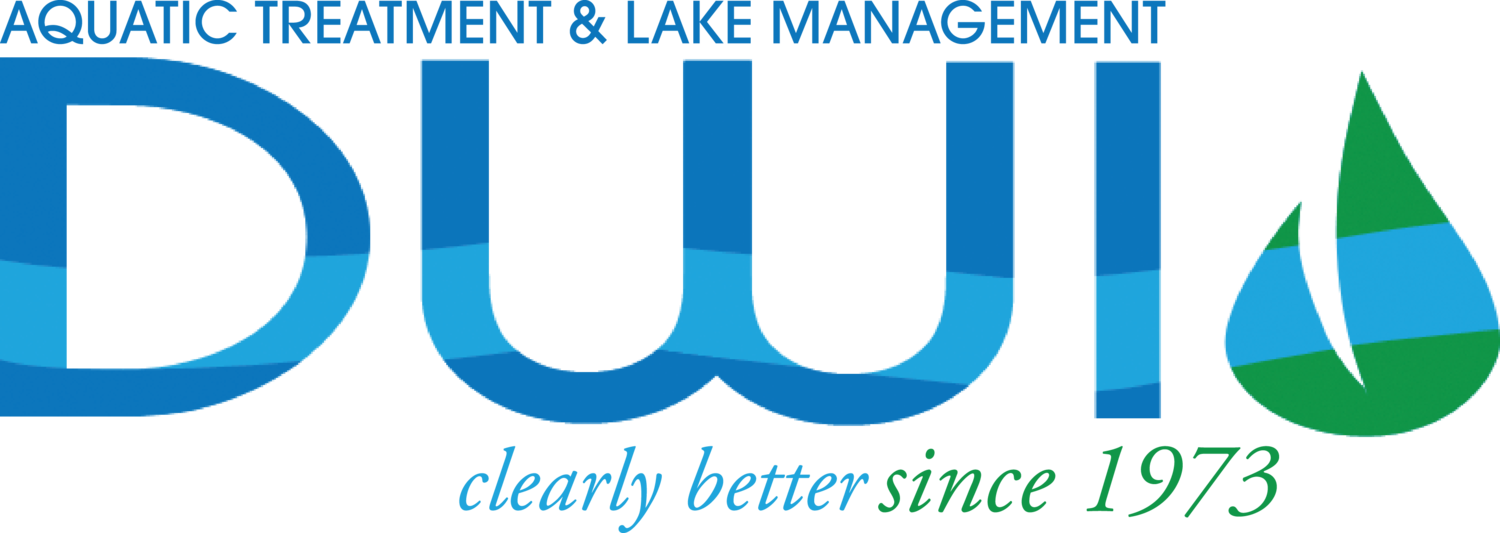By Patrick Simmsgeiger, Founder of DWI
In September of 2000, a call came from a southern Orange County, CA water district regarding Dove Canyon Lake, a ten-year-old, 450 surface acre lake that had seen a growth spurt of water hyacinth. Water hyacinth is a beautiful but rapid-growing and troublesome aquatic plant. Its deep green color and appealing purple blooms add to the aesthetics of a lake, but the plants can double in population in under twelve days. In addition to the obvious problems of preventing boat access, swimming and fishing, an overgrowth of water hyacinth prevents sunlight from penetrating the lake surface to allow the growth of beneficial plants, cut off oxygen, leading to fish kills, and adversely affects the lake’s aesthetics, fish habitats, biological balance and odor.
The water district requested a consultation regarding treatment and maintenance of the lake from Patrick Simmsgeiger, owner of Diversified Waterscapes, Inc. (DWI), a licensed pest control business. Mr. Simmsgeiger holds a qualified applicator’s license and is a certified lake manager through NALMS (North American Lake Management Society). After first inspecting the lake, Mr. Simmsgeiger met with country water district representative to discuss control products, and the methods and frequency of application to use to eliminate water hyacinth.
The lake had its challenges. There were huge areas of open water, but also small fingers and areas too narrow for a boat to navigate. Diversified’s boat and outboard motor could be used to treat the larger portions of lake, but the boat would have to be used without the outboard in the small coves. There were areas where a boat could not go at all, and these areas would require application from the shore with a backpack sprayer, or treatment from the top of the hillside with a high-power hose hosing a large tank attached to the company truck or a golf cart.
After careful evaluation, a solution was devised to treat the aquatic plant problem and work began mid-December of 2000. A small boat equipped with a custom-made sprayer was used to apply algaecide, formula F-30, Algae Control® (Diversified Waterscapes) along with herbicide, Reward® (Syngenta), to kill the water hyacinth. No other control options were considered, as the company already knew that the safest, most effective and rapid method to control water hyacinth was to use a spray tank mix of algaecide and herbicide. In this case Diversified used five (30 gallon) tanks. Each tank mix had two (2) gallons of Reward® with five (5) gallons of F-30 Algae Control®. This combination is used regularly by DWI not only because it is safe for aquatic life, but also because it is known to regularly improve water quality. At the time of application, the water hyacinth was not “out of control” but was a nuisance due to its excessive growth. The treatment method and products used were successful, but the customer declined the usual necessary follow-up treatment and twice-monthly monitoring.
In May 2001 the water district again called DWI to request another spray treatment of water hyacinth. Because five months had passed with no monitoring or maintenance treatments, it was necessary to check the lake for changes in plant life or water conditions. Because of regrowth, the water hyacinth had returned to its former state. DWI suggested and implemented a new course of spray treatments.
Within each aquatic environment, the question of how often to treat is one that is answered by DWI with a request towait and see. EACH lake, pond or stream is DIFFERENT. One lake can experience rapid growth of a weed or form of algae while another lake only a few feet away has beautiful clarity, no algae or weeds, and rarely requires attention. Like terrestrial plants, aquatic plants will take whatever opportunity offered to grow again. However, you never want to introduce the quality of water treatment products necessary to kill everything, as the balance of the ecosystem will be destroyed and the lake will be killed.
After treatment of the water hyacinth was completed, DWI called the water district two to three times, made site visits, and performed aerial observations. During this two-year period the water district trained and certified some of its employees to treat and maintain control of water hyacinth. However, they could not recall what types, brands or qualities of products they used during this period of time. The lake was surrounded by hillsides that are now dotted with million dollar homes for which the main selling feature is the view, capturing the beauty of the surrounding hillsides and mountain areas, and directly below, the lake. The original design and purpose of the lake was to catch and store rain and hillside runoff. However, the lake was by now a catch-all for residential runoff, accumulating nutrients from debris, tree droppings, car oils, soaps, etc. This runoff “fed” the plants, unbalancing the ecosystem and wreaking havoc with the clarity, appearance, odor and plant growth in the lake, which had now become a source of numerous complaints.
In July 2003, DWI received a call from the water district, this time requesting a harvester (separate contractor) for the water hyacinth. This call was what DWI termed a “warning flag”. Requesting a harvester usually means that there is a large body of water with a massive problem with weeds and/or algae.
When Diversified Waterscapes Inc. arrived, we discovered that the water hyacinth had returned with a vengeance, covering approximately 75% of a 21 surface-acre portion of Dove Canyon lake. The water hyacinth population was expanding at a rate of one foot per day and was killing the lake. A strong “attack” was scheduled after the harvester, using the same chemical mixture approach in 2000 for treatment. The goal of the treatment was to totally eradicate the water hyacinth, not to gain and maintain control of the plant’s growth. Most caretakers of aquatic environments keep certain areas of the water covered with the hyacinth because it is so attractive. In this case, the water district requested that all of the invasive plant be removed.
The reason for a follow-up treatment after harvesting is that once a harvester is used, seeds and stems from the weeds and algal spores are released and spread. If these reproductive units are hit with a treatment of herbicide and algaecide mix, re-growth will be minimal and slow. Because the weather was extremely hot and the sun was beating down on the water’s surface, (contributing factors to rapid growth) the water hyacinth was coming back faster than it could be harvested. The district requested that DWI perform spray treatments while the harvesting was taking place. Some portions of the lake were still densely covered with hyacinth, which made treatments challenging.
The herbicide and algaecide spray treatment was performed one day, under normal circumstances to be followed by a wait period. As after initial treatment, it is important to allow time (three to seven days) for the products used in the treatment to “settle” and do their job. Then, the developing results can be monitored. This approach enables the applicator to factor in the speed at which the products worked, judge the effectiveness of the “kill”, and decide if adjustments in the approach are needed for subsequent treatments. In this case, due to the incredibly rapid re-growth of hyacinth the lake was experiencing, another crew was sent out the very next day, followed by another treatment a few days later.
The combined treatments were so successful that the district called DWI a bit later for a different, but larger area, of the lake that was experiencing problems with water hyacinth, algae and duckweed. Spray treatments were performed using the same herbicide, Reward® and algaecide, F-30 Algae Control®- this time adding a surfactant, Activator 90®, to the mix (because more than the water hyacinth was involved). This combination was quite successful.
After implementing DWI’s treatment program total eradication of the water hyacinth was, at that point, achieved. The problem was resolved and the water district was satisfied. However, one cannot consider this a “permanent” solution. A “permanent” solution could involve the overuse of chemicals and the risk of killing the very body of water you are trying to save. Diversified Waterscapes does not ascribe to this control strategy. Water district personnel were advised to immediately remove the occasional regrowth of water hyacinth and the plant has not returned to overtake Dove Canyon Lake.
Conclusion
The invasive plant was virtually eliminated and the associated odor and appearance problems were resolved. The lake became aesthetically pleasing again to the homeowners and the complaints stopped. The lake is now alive and accessible. The treatment process, from the very first treatment to the last, had spanned a period of two and a half years. The cost of the one month of total chemical treatments was close to $20,000.00, and the harvesting took two and a half weeks at a cost nearing $45,000.00, all to eliminate growth of weeds and algae that had increased to the point of being out of control.
A lake maintenance company has been performed follow-up treatments of the same reservoir and lake to control the re-growth of the water hyacinth and manage the duckweed and algae. There have been regular treatments and the hyacinth has never come close to reaching the state it did in 2003.
The less learned? You can’t treat and walk away. You have to perform regular maintenance on a body of water. Maintenance means to keep in an existing state to preserve from failure or decline. And that’s what lake, stream and pond maintenance is all about, restoring bodies to a more natural, appealing state and keeping them that way.
Regardless of what part of the US you are from, Diversified’s products and methods of application make a difference in water quality and aquatic plant and weed control.



